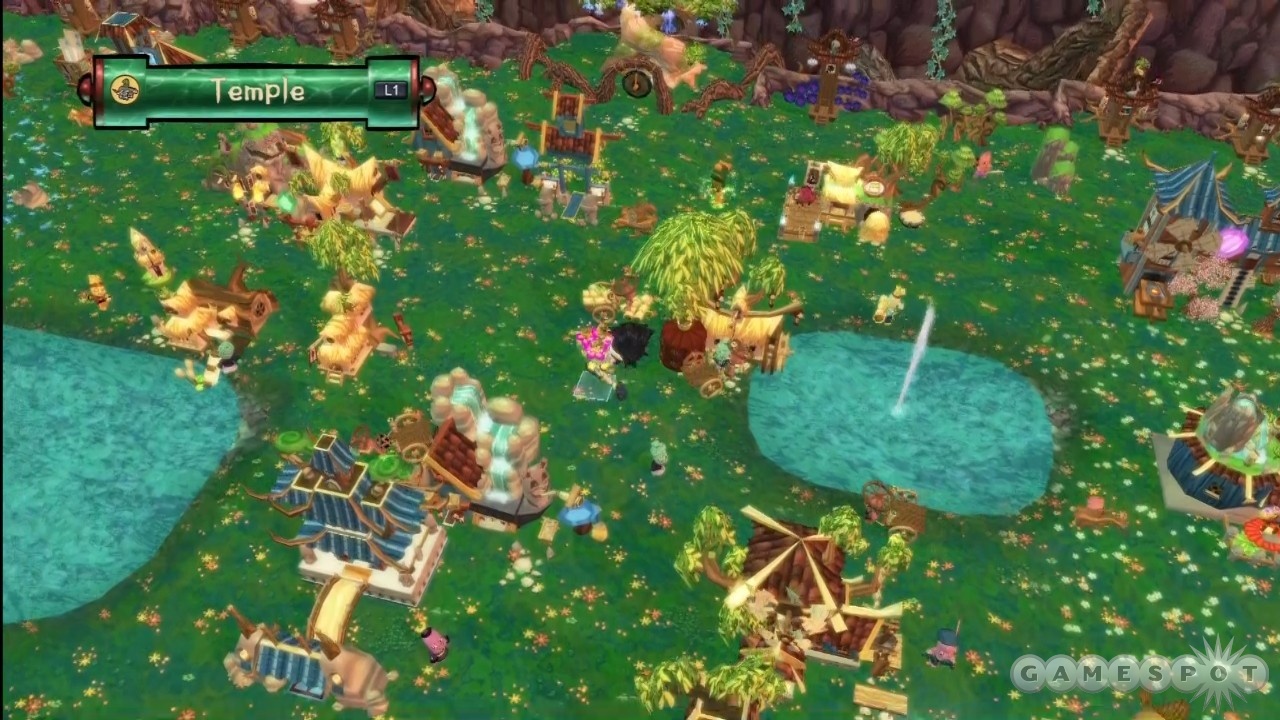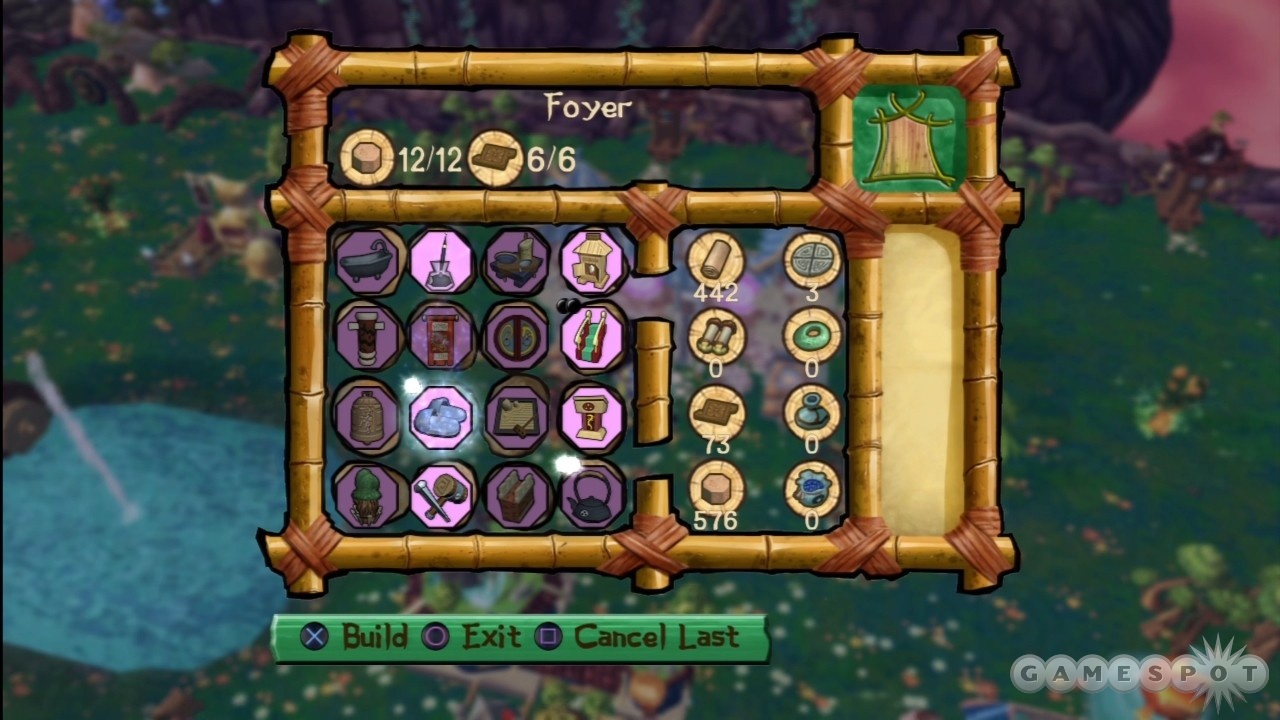There's a fine line between laid-back and boring, and Akimi Village doesn't always fall on the right side of it. This easygoing city builder's appeal is also its greatest liability: a slow pace. Sometimes, the relaxed tempo lulls you into a sense of comfort, as you roam through the game's green meadows, lugging around bonsai trees and chilling to the reassuring soundtrack. Other times, the amount of time it takes to perform any given task reveals the game's primary flaw: it's all just busywork. Developer Ninjabee's previous games in this vein--A Kingdom for Keflings and A World of Keflings--alleviated some of the potential boredom with online co-op, mini-quests, and multiple maps. Akimi Village takes the simple template of those games and makes it even simpler--and thus, less compelling. Yet while you might struggle with bouts of occasional tedium, it's rewarding to watch your petite empire take form, and to turn the world's gloomy pockets of blackness into sunny pastures ready to be harvested for their stone and wood.
Akimi Village is a city builder with a focus on supply lines. As either a male or female avatar, you develop the village by assigning collection and transport tasks to blue creatures called Akimi. To give an Akimi a job, you pick one up and set it in front of the resource you want it to gather or the pile of resources you want it to transport. Then, you drop it in front of the structure you want it to transport these goods to. From here, you walk up to various supply structures and order components to be produced. To build structures, you pick up these components one at a time and drop them on an available plot of land. Need to build a workshop? Head to your work hut and queue up the right trinkets. Want a temple? That requires that you have a workshop, a sculptor, a gardener, and a master craftsman first, because each building produces items necessary for your temple's creation. Once you get used to the largely pictorial interface, it's easy to understand how to bring your plans to fruition. Each structure's construction menu identifies what you need to queue up based on your currently chosen blueprint, and a glowing cursor highlights the ground where you should place each component.
As you progress, buildings require more and more objects to complete them, and thus, more complex supply chains. As a result, you need to put more and more Akimi to work. There are available helpers scattered about the land, but they aren't available for serfdom immediately. These Akimi roam dark, colorless land called The Gloom. Every so often, you earn a special acorn for a job well done. To free gloomy Akimi from their dismal existence, you drop these acorns into fissures known as spirit wells. Doing so causes a flowery flourish of color, and the sun again shines on a chunk of previously miserable land where the freed Akimi are now thrilled to do your bidding. In city builders, it's always a delight to see a bustling community emerge from almost nothing. Watching these dead areas spring to life enhances that inherent satisfaction even further.

Unfortunately, where Akimi Village stumbles is in its moment-to-moment pacing. As your modest kingdom grows, you must haul objects further and further across the map. Because later structures require many more components than early ones, you eventually spend a lot of time trekking across the same stretches of land just to assemble a single dojo. This often leads to monotony, which is exacerbated by some of Akimi Village's small but irritating issues. Some structures are add-ons to existing ones, such as the gate and the temple. You might place the initial buildings close to other structures or resource nodes, only to discover later that you've built yourself into a corner and have to move a structure to another spot. The problem? In order to do so, you have to deconstruct it and move every individual component. And thus, you add another exhausting five minutes to an already slow task. A World of Keflings already addressed this issue by letting you move entire buildings; that it wasn't dealt with here is flabbergasting.
For that matter, the Keflings games broke up the drudgery in a number of ways, such as short quests, different environments, and even assistants that could finish build tasks on your behalf. Akimi Village takes place on one pretty but otherwise uninteresting map and involves creating supply lines and then walking around and building stuff--but nothing more. Without the little touches to keep you interested, Akimi Village reveals this formula for what it is: a shallow city builder in which you control the slowest mouse cursor ever. Eventually you can build portals that help ease the grind of trudging back and forth, but you'll long for the ability hours before you actually unlock the portal blueprint.

Yet while this slow pace can make for monotony, it is sometimes agreeably Zen-like. This is a sandbox game without pressure or time constraints. The soundtrack is made up of lush harmonies, tinkling glockenspiel melodies, and occasional vocalizations, sometimes laid on top of lively beat patterns. The music is tranquil in just the right way. Any more energetic and it would have been too cutesy; any more stagnant and it might have put you to sleep. Watching Akimi cheerfully pull rickshaws and prance about with bundles of straw in their arms will endear them to you, and the sad Akimi ambling in The Gloom look so despondent, they may break your heart. There's a good-natured, sometimes surreal charm to the structure descriptions and bits of dialogue. (The inn description states: "Visiting Akimi stay at the local inn. It doesn't have Wi-Fi, but the Akimi don't mind.") When you don't move for a while, your avatar rises into the air in a lotus position--a nice touch in a game designed to relax you.
All too often, however, Akimi Village stops being relaxing and becomes boring. It takes about six to eight hours to restore this single village to its former glory, but while the game is long as far as downloadable games go, it is never substantial--what would amount to an hour's worth of gameplay with a mouse cursor stretched into a full $9.99 game. There's never a reason you should run out of supplies; as long as you have proper supply lines set up, resources take care of themselves. Nonetheless, you can send resources to other players on your friend's list, or even take a look at their village. What you can't do, however, is join them--either online or locally. (Co-op play is another feature inexplicably stripped from the formula.) Co-op play, like quests and visual diversity, could have broken up the monotony that so often visits this quirky village. But if you're the patient sort looking for a diversion on a lazy afternoon, this peaceful city builder might soothe your savage inclinations.